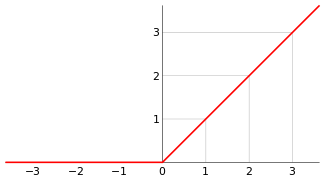Ramp function

The ramp function is a unary real function, easily computable as the mean of the independent variable and its absolute value.
This function is applied in engineering (e.g., in the theory of DSP). The name ramp function is derived from the appearance of its graph.
Definitions
The ramp function ( ) may be defined analytically in several ways. Possible definitions are:
) may be defined analytically in several ways. Possible definitions are:
or
- The mean of a straight line with unity gradient and its modulus:
this can be derived by noting the following definition of  ,
,
for which  and
and 
- The Heaviside step function multiplied by a straight line with unity gradient:
- The convolution of the Heaviside step function with itself:
- The integral of the Heaviside step function:
Analytic properties
Non-negativity
In the whole domain the function is non-negative, so its absolute value is itself, i.e.

and

- Proof: by the mean of definition [2] it is non-negative in the I. quarter, and zero in the II.; so everywhere it is non-negative.
Derivative
Its derivative is the Heaviside function:

From this property definition [5]. goes.
Fourier transform





Where δ(x) is the Dirac delta (in this formula, its derivative appears).
Laplace transform
The single-sided Laplace transform of  is given as follows,
is given as follows,

Algebraic properties
Iteration invariance
Every iterated function of the ramp mapping is itself, as
 .
. - Proof:



 .
.
We applied the non-negative property.







